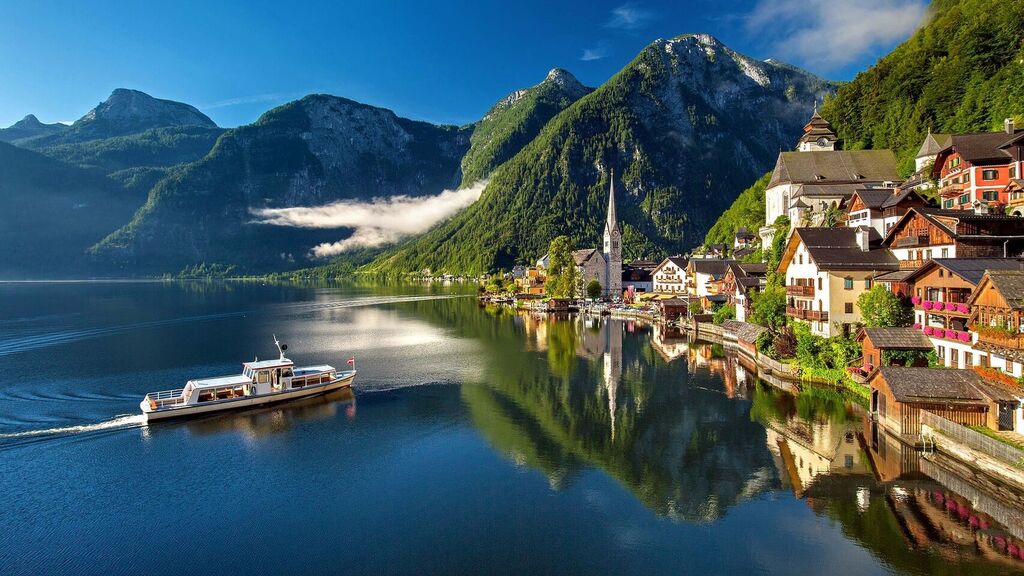Hallstatt, a dream town in Austria

Among all the tourist attractions of Austria, a unique town whose beauty is incomparable stands out, we refer to the town of Hallstatt, surrounded on one side by beautiful mountains of incomparable size and on the other side by a large lake of crystalline water.
Hallstatt has many curiosities to offer, especially as far as history is concerned. In addition, its landscapes are beautiful. It was declared a World Heritage Site by Unesco in 1997.
Between mountains and lakes, the beautiful town of Hallstatt is located, whose name is due to the abundant salt in its nearby mines. Closed to the public until the 19th century, Hallstatt, in Austria, is an excellent option to enjoy rural life and truly magical landscapes.
Hallstatt, an inhospitable place
The first vestiges of human life in Hallstatt date back to 5000 BC. The salt deposits were what allowed communities to be established there.
Various investigations conducted in the mid-nineteenth century found a prehistoric cemetery near the current town.
In total, nearly a thousand graves were placed and excavated perfectly, as if it were a drawing.
The only possibility that existed to get to Hallstatt was by boat or by narrow and somewhat complicated paths. The mountains and Lake Hallstatter See made the crossing very difficult.
The few houses that had been built there were accessible through some walkways that overlooked the attics. We had to wait until 1890 to see a path through the rock.
Stroll through Hallstatt
This town of almost a thousand inhabitants is not yet ready for tourism. Although it has structure and facilities, it is often exceeded by the number of visitors that arrive.
The best option, therefore, is to book a hotel room in advance. The unmissable corners of Hallstatt for those who get there are the following:
Salt mine
It is said to be the oldest in the world, with 7,000 years of exploitation. To get there, you can go on foot or by a funicular that runs from April to October, from 9 a.m. to 6 p.m.
Inside the mine there is a museum that exhibits the body of a man found in 1734. This man still retains clothes and tools, but was preserved by salt and therefore did not decompose.
Catholic Parish Church
It is of small dimensions and Gothic style; Its construction began in 1181 and ended in 1505. During the religious wars in the area, it was used by Catholics and Protestants in an alternative way. Next to it, it has a tiny mountain cemetery.
Protestant church
It is neo-Gothic and was built in 1863. At that time of religious reform, the miners chose Protestantism and needed a meeting place.
For this reason, this temple was erected shortly after the emperor Francisco José I declared that both the Catholic and the Protestant faith had to be accepted equally in Hallstatt.
Archaeological excavations
They show us a series of objects found in tombs dating from the so-called ‘Hallstatt era’ between 1300 and 400 BC, of great prosperity and splendor.
Remains of Roman foundations, metal and ceramic utensils and three forges of the mine with a hammer mill are some of the vestiges of this place.
Rudolf Tower I
From the top of this construction in honor of the first monarch of the Habsburg Empire, we can enjoy a panoramic view of the entire area. The tower was built in 1282 by Duke Albrecht I to defend the town of Salzberg miners.
Between 1313 and 1953 (640 years) it was the home of the salt mine manager. In 1960, a restaurant was opened.
Kalvarienberg Church
Its construction was carried out in 1711, but later it had to be restored. For this, 2,500 woods were used, donated by a wealthy couple without children, who wanted this place to be their final resting place.
An excellent way to get to Hallstatt is by train from Vienna or Salzburg, via the line that connects these two cities.
To get to the town, you have to get on a ferry or small boat, to enjoy what will come. Another option is the bus from Salzburg to Bach Ischl, and from there the regional train and the ferry.
Beautiful at any time of the year, but more ‘permissive’ in spring and summer, Hallstatt is a magical place and surrounded by dreamlike landscapes. You won’t want to leave there anymore.





